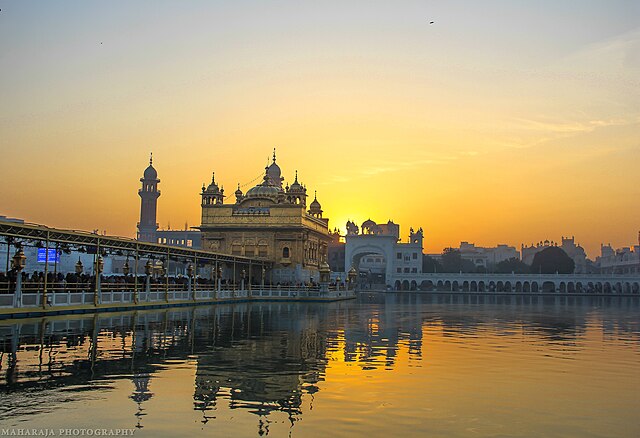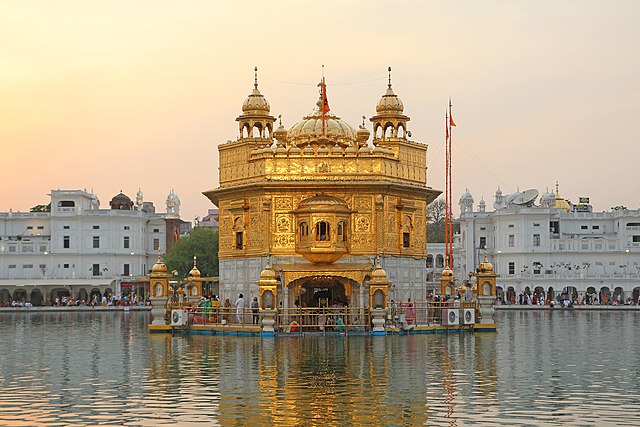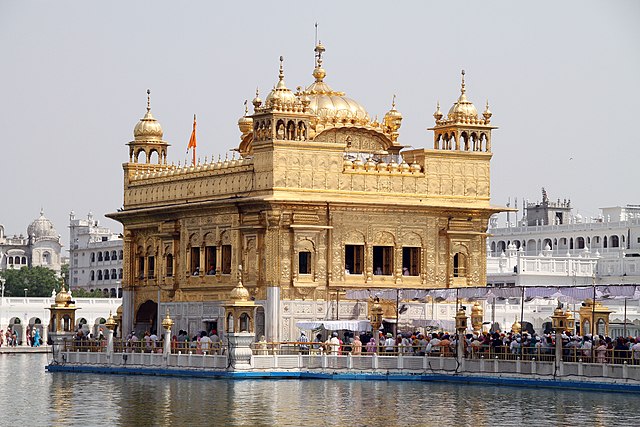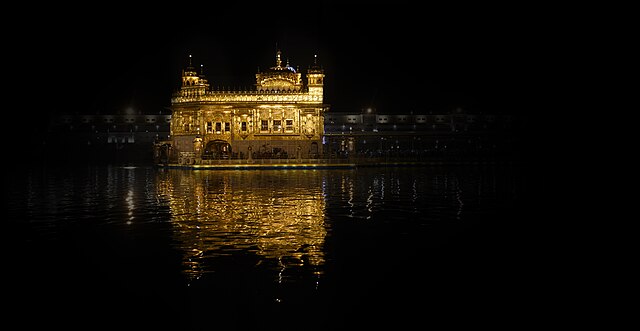Have you ever wondered what makes a place so sacred that millions of people from every corner of the world make pilgrimages to visit it? Sri Harmandir Sahib, commonly known as the Golden Temple, stands as one of the most revered religious sites on Earth. This magnificent structure in Amritsar, Punjab, isn’t just a building covered in gold – it’s a living testament to faith, equality, and human compassion.
When you first lay eyes on Sri Harmandir Sahib, with its gleaming golden dome reflecting in the sacred waters of the Amrit Sarovar, you’re witnessing more than architectural beauty. You’re seeing the physical manifestation of centuries of devotion, struggle, and unwavering faith. This isn’t just another tourist destination; it’s the spiritual heart of Sikhism and a beacon of hope for people of all backgrounds.
What Makes Sri Harmandir Sahib So Special?
Think of Sri Harmandir Sahib as more than just a temple – it’s a revolutionary concept wrapped in gold. While most religious structures of its time were built on elevated platforms to symbolize superiority, the Golden Temple was deliberately constructed at a lower level. Why? Because it represents humility and the belief that one must step down to reach the divine.
The temple welcomes everyone, regardless of their religion, caste, creed, or social status. It’s like a spiritual democracy where every person is equal in the eyes of the divine. This inclusivity isn’t just theoretical – it’s practiced every single day through the temple’s various services and rituals.
The Spiritual Significance Behind the Golden Walls
The gold covering isn’t just for show – it carries deep spiritual meaning. Gold, being incorruptible and eternal, represents the timeless nature of divine truth. When Maharaja Ranjit Singh decided to cover the temple with gold in the early 19th century, he wasn’t just making it beautiful; he was creating a physical symbol of the imperishable nature of Sikh teachings.
The golden facade serves as a mirror, reflecting not just light but the hopes and prayers of countless devotees. It’s said that the temple looks different at various times of the day – sometimes appearing as if it’s on fire at sunset, other times glowing like a gentle moon in the evening light.
More Than Just Architecture: A Symbol of Unity
Sri Harmandir Sahib stands as a powerful symbol of unity in diversity. The temple’s design incorporates elements from both Hindu and Islamic architecture, reflecting the inclusive nature of Sikh philosophy. The dome is reminiscent of Mughal architecture, while the overall structure follows traditional Indian temple design principles.
This architectural fusion isn’t accidental – it’s a deliberate statement about harmony between different cultures and religions. Just as the building brings together different architectural styles, the temple brings together people from different walks of life under one roof.
The Rich History of Sri Harmandir Sahib

Every stone of Sri Harmandir Sahib tells a story. The temple’s history is intertwined with the development of Sikhism itself, making it not just a religious site but a historical treasure trove that has witnessed the rise and challenges of an entire faith community.
Guru Arjan Dev Ji’s Vision Comes to Life
The story begins with Guru Arjan Dev Ji, the fifth Sikh Guru, who envisioned a central place of worship for the growing Sikh community. In 1588, he began the construction of what would become the most important Sikh shrine in the world. But this wasn’t just about building a temple – it was about creating a spiritual center that would serve as the heart of Sikh identity.
Guru Arjan Dev Ji’s vision was revolutionary for its time. He wanted a place that would be accessible to all, where the rich and poor could worship side by side. The Guru himself laid the foundation stone, but in a gesture that speaks volumes about Sikh values, he invited Mian Mir, a Muslim Sufi saint, to lay the foundation stone of the temple.
From Foundation to Golden Glory
The temple’s journey from a simple structure to the golden marvel we see today spans several centuries. Each phase of construction and renovation tells a story of devotion, destruction, and rebirth that mirrors the challenges faced by the Sikh community throughout history.
The Original Construction (1588-1604)
The original temple was completed in 1604, and it was here that Guru Arjan Dev Ji installed the first copy of the Guru Granth Sahib, making it the first Gurdwara to house the sacred text. The temple was built using white marble and was surrounded by a rectangular pool filled with water considered sacred by devotees.
The construction process itself was a community effort. People from all walks of life contributed labor, materials, and funds. This collective effort established a tradition that continues today – the temple belongs to the community and is maintained by the community.
Maharaja Ranjit Singh’s Golden Touch
The transformation of Sri Harmandir Sahib into the “Golden Temple” happened during the reign of Maharaja Ranjit Singh in the early 19th century. Between 1803 and 1830, the Maharaja commissioned the covering of the temple with gold leaf, creating the stunning golden facade that gives the temple its popular name.
This wasn’t just about aesthetics – it was about creating a symbol of Sikh prosperity and power. The gold covering represented the community’s rise from persecution to prominence, from being hunted to being rulers of their own kingdom.
Architectural Marvel: Understanding the Design

Sri Harmandir Sahib is an architectural masterpiece that combines beauty with deep spiritual symbolism. Every element of its design has been carefully planned to create not just a visually stunning structure, but a space that facilitates spiritual connection and communal harmony.
The Unique Four-Door Concept
One of the most distinctive features of Sri Harmandir Sahib is its four doors, each facing a different direction. This design choice wasn’t arbitrary – it’s a powerful symbol of the temple’s openness to people from all directions and all backgrounds. Whether you’re coming from the north, south, east, or west, there’s a door waiting to welcome you.
This four-door concept is unique among religious buildings and reflects the Sikh principle of universal brotherhood. It’s as if the temple is saying, “No matter where you come from or what path you’ve taken in life, you’re welcome here.”
Sacred Pool and Its Significance
The temple sits in the center of a rectangular pool called the Amrit Sarovar, which means “Pool of Nectar.” This isn’t just a decorative water feature – it’s central to the temple’s spiritual significance and daily rituals.
The Amrit Sarovar: Waters of Immortality
The sacred pool is believed to have healing properties, and thousands of devotees take a dip in its waters daily. The pool is about 154 feet long and 154 feet wide, with marble steps leading down to the water on all sides. The water is constantly circulated and cleaned to maintain its purity.
The pool serves multiple purposes: it’s a place for ritual bathing, a source of water for the temple’s various needs, and a stunning setting that enhances the temple’s beauty. The reflection of the golden temple in the still waters creates a breathtaking image that has inspired countless artists and photographers.
Daily Life and Rituals at the Golden Temple
Sri Harmandir Sahib isn’t just a monument to be admired from afar – it’s a living, breathing center of spiritual and community life. Every day, from before dawn until late at night, the temple buzzes with activity as thousands of devotees participate in various rituals and services.
The Continuous Recitation of Guru Granth Sahib
At the heart of daily life at Sri Harmandir Sahib is the continuous recitation of the Guru Granth Sahib, the holy book of Sikhism. This isn’t just a reading – it’s a musical presentation where trained musicians and singers present the sacred verses in traditional ragas (musical modes).
The day begins before dawn with the Prakash ceremony, where the Guru Granth Sahib is brought from its resting place and ceremonially opened. This marks the beginning of the day’s spiritual activities. Throughout the day, different sections of the holy book are recited, ensuring that the temple resonates with sacred music and prayers.
Langar: The World’s Largest Free Kitchen
Perhaps no aspect of Sri Harmandir Sahib is more remarkable than its langar – the community kitchen that serves free meals to anyone who walks through its doors. This isn’t just about feeding people; it’s about putting the Sikh principle of equality into practice in the most basic and fundamental way possible.
How 100,000 People Are Fed Daily
The numbers are staggering: the Golden Temple’s langar serves free meals to over 100,000 people every single day. During festivals and special occasions, this number can double or even triple. The operation runs 24 hours a day, 365 days a year, making it one of the largest food service operations in the world.
But here’s what makes it truly special – everyone sits on the floor at the same level, regardless of their social status, wealth, or background. A millionaire businessman sits next to a homeless person, a government official next to a laborer. This isn’t just symbolic equality; it’s practical equality in action.
The food is simple but nutritious – typically dal (lentils), vegetables, rice, and chapati (flatbread). The meals are prepared by volunteers who come from all walks of life, including celebrities, politicians, and ordinary citizens who consider it an honor to serve in the Guru’s kitchen.
Visiting Sri Harmandir Sahib: A Pilgrim’s Guide

Planning a visit to Sri Harmandir Sahib? You’re in for a transformative experience. But like any sacred space, there are certain protocols and traditions that visitors should understand to make the most of their visit while showing proper respect.
Best Times to Visit
While Sri Harmandir Sahib is open 24 hours a day, 365 days a year, timing can significantly impact your experience. Early morning hours (4-6 AM) offer a more peaceful atmosphere with fewer crowds, allowing for quiet contemplation and better photography opportunities.
Evening hours, particularly around sunset, provide spectacular views as the golden temple is illuminated against the darkening sky. However, these are also the busiest times, so be prepared for crowds.
Avoid major Sikh festivals if you prefer a quieter experience, but consider visiting during these times if you want to witness the temple at its most vibrant and celebratory.
Dress Code and Etiquette
Visiting Sri Harmandir Sahib requires adherence to certain dress codes and behavioral norms that reflect respect for the sacred space. All visitors must cover their heads – scarves are provided free of charge if you don’t have one. Shoes must be removed and left at designated areas; socks are recommended for hygiene and comfort.
Modest clothing is required – no shorts, short skirts, or sleeveless tops. The idea is to dress as you would when visiting any respected elder or sacred space. Tobacco and alcohol are strictly prohibited, as is any form of disruptive behavior.
What to Expect During Your Visit
Your visit will likely begin at one of the entrance gates where you’ll go through security and remove your shoes. You’ll then walk through the outer courtyard, perhaps stopping at the information center or to cover your head if needed.
The approach to the temple itself is via a marble walkway that leads through the main entrance. As you walk, you’ll hear the continuous recitation of the Guru Granth Sahib, which creates a meditative atmosphere.
Inside the temple, you can circumambulate (walk around) the central shrine, participate in the langar, or simply sit and absorb the spiritual atmosphere. Many visitors find that their planned short visit extends into hours as they become absorbed in the peaceful environment.
The Golden Temple’s Role in Sikh Culture
Sri Harmandir Sahib isn’t just a building – it’s the beating heart of Sikh culture and identity. For Sikhs around the world, the Golden Temple represents home, no matter where they might be living. It’s the place where their faith was formalized, where their sacred texts were first housed, and where the principles they live by are practiced daily.
Center of Sikh Spirituality
The temple serves as the spiritual headquarters of Sikhism. Important religious decisions are made here, and it’s the place where Sikhs come to connect with their faith in its purest form. The Akal Takht, one of the five seats of Sikh authority, is located within the temple complex, making it not just a place of worship but also a center of religious governance.
For many Sikhs, visiting Sri Harmandir Sahib is a pilgrimage that connects them to their roots and strengthens their faith. The experience of participating in the langar, listening to the continuous recitation of the Guru Granth Sahib, and being part of the community that gathers here daily provides a profound sense of belonging and spiritual fulfillment.
Cultural Festivals and Celebrations
Throughout the year, Sri Harmandir Sahib hosts numerous festivals and celebrations that showcase the richness of Sikh culture. Vaisakhi, which commemorates the formation of the Khalsa, transforms the temple into a vibrant celebration of Sikh identity and values.
Guru Nanak’s birthday, the martyrdom days of various Gurus, and other significant dates in the Sikh calendar are observed with special prayers, processions, and community gatherings. These celebrations aren’t just religious observances – they’re cultural events that bring together Sikhs from around the world and welcome visitors from other communities.
Challenges and Preservation Efforts
Maintaining a structure as old and significant as Sri Harmandir Sahib presents unique challenges. The temple faces the constant pressure of millions of visitors, environmental factors, and the need to preserve its historical and spiritual significance while accommodating modern needs.
Maintaining the Sacred Structure
The daily wear and tear from thousands of visitors, combined with environmental factors like pollution and weather, requires constant maintenance. The marble walkways need regular cleaning and repair, the gold plating requires periodic maintenance, and the infrastructure must be updated to handle the massive crowds while preserving the temple’s sacred character.
The Shiromani Gurdwara Parbandhak Committee (SGPC), which manages the temple, has implemented various measures to protect the structure while ensuring it remains accessible to all. This includes regulating visitor flow during peak times, implementing conservation measures, and using modern technology to monitor the temple’s condition.
Modern Conservation Techniques

Recent years have seen the implementation of modern conservation techniques to preserve Sri Harmandir Sahib for future generations. This includes scientific analysis of the building materials, controlled environment systems to protect the sacred texts, and advanced water treatment systems for the Amrit Sarovar.
The challenge is balancing preservation with accessibility. The temple must remain a living, breathing center of worship while being protected as a historical monument. This requires careful planning and the use of cutting-edge conservation science combined with traditional craftsmanship.
Conclusion
Sri Harmandir Sahib stands as more than just a religious building – it’s a testament to the power of faith, community, and human equality. From its humble beginnings as Guru Arjan Dev Ji’s vision to its current status as one of the world’s most visited religious sites, the Golden Temple has remained true to its founding principles while adapting to the needs of each generation.
The temple’s golden walls reflect not just sunlight, but the hopes, dreams, and prayers of millions of people who have found solace, community, and spiritual fulfillment within its sacred confines. Whether you’re a devout Sikh, a curious traveler, or someone seeking spiritual connection, Sri Harmandir Sahib offers an experience that transcends religious boundaries and speaks to the universal human longing for peace, equality, and divine connection.
As you plan your visit or simply reflect on what this magnificent structure represents, remember that Sri Harmandir Sahib is not just a destination – it’s a living example of how faith, when combined with compassion and service, can create something truly extraordinary. In a world often divided by differences, the Golden Temple stands as a shining beacon of what’s possible when we embrace our shared humanity.
Frequently Asked Questions
1. Do I need to be Sikh to visit Sri Harmandir Sahib?
No, Sri Harmandir Sahib welcomes visitors from all religions and backgrounds. The temple’s four doors symbolize its openness to people from all directions and faiths. However, all visitors must follow the dress code and behavioral guidelines out of respect for the sacred space.
2. Is the food at the langar really completely free?
Yes, the langar (community kitchen) at Sri Harmandir Sahib serves completely free meals to anyone who visits, regardless of their religion, nationality, or economic status. This service operates 24/7 and feeds over 100,000 people daily, making it one of the largest free food services in the world.
3. How long does it typically take to visit the Golden Temple?
A basic visit can take 2-3 hours, but many people spend much longer. This includes time for darshan (viewing the holy book), walking around the temple, participating in the langar, and exploring the complex. Some visitors find the atmosphere so peaceful that they stay for several hours.
4. What should I expect during my first visit to Sri Harmandir Sahib?
Expect a sensory-rich experience with continuous sacred music, beautiful architecture, and a diverse crowd of devotees and visitors. You’ll need to cover your head, remove your shoes, and dress modestly. The atmosphere is generally peaceful and welcoming, with volunteers often available to help first-time visitors.
5. Can I take photographs inside Sri Harmandir Sahib?
Photography is generally allowed in the outer areas and courtyards of the temple complex, but restrictions may apply inside the main temple building, especially during religious ceremonies. It’s always best to ask permission and be respectful of ongoing religious activities. Many visitors find that the most meaningful moments are best experienced rather than photographed.

